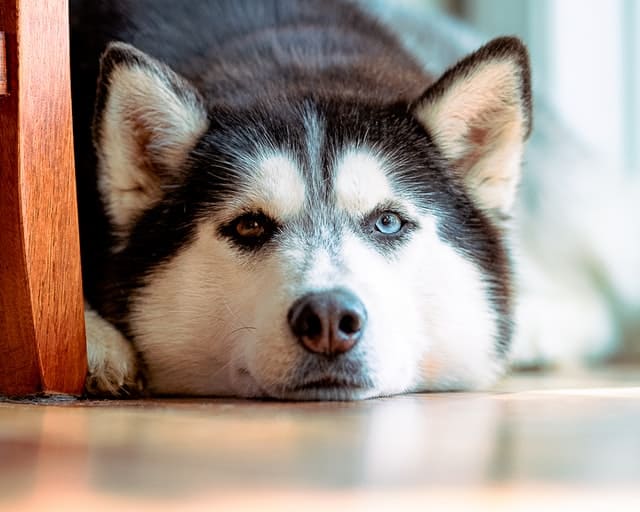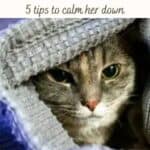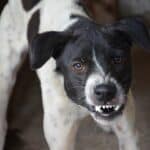
In the summer season, pets add new fears to other fears: peals of thunder and bright flashes of lightning in the sky scare, make you worry. Many animals, hearing thunder, begin to rush, try to run away and hide. Once on the street during a thunderstorm, the dog can break off the leash and run away, get lost. What should the owner do if the dog is afraid of a thunderstorm?
Should you be worried about of dog’s fear of thunderstorm
Yes, be afraid, because stress makes your pet very anxious, which negatively affects its health. This is especially dangerous for older animals.
Dogs have a highly organized nervous system, and stress is the body’s response that helps the animal survive. From the point of view of physiology, stress is the tension of protective forces in response to the influence of one or another irritating factor. This is a complex complex of biochemical processes, which is manifested by a change in the physiology or behavior of an animal.
Frequent exposure to stress factors lowers immunity, increases the risk of infectious diseases, and the development of malignant tumors. Against the background of constant tension of the nervous system, the animal develops neuroses, which causes a change in behavior. Relapses of chronic diseases occur more often – of the cardiovascular, digestive systems, allergic skin diseases appear.
Note: With age, animals show more and more physiological problems, so stress is especially dangerous for older dogs.
Why dogs are afraid of thunderstorms
Many animals – both wild and domestic – sense the approach of a thunderstorm even before its first signs appear. A cat, for example, chooses a warmer and more comfortable place to sleep, and a dog shows signs of anxiety: she is reluctant to go for a walk, although she previously showed active joy at the sight of a leash. Once on the street, the animals strive to return home as soon as possible, and in the room they whine, their ears folded, nestle against the mat, trying to appear as small as possible. If your pet is trying to get under the closet or sofa, nestles at the feet of the owner – wait, a thunderstorm will begin soon.
Scientists have not yet figured out how animals feel the approach of bad weather and why dogs are afraid of a thunderstorm. There are suggestions that they are frightened by sudden changes in atmospheric pressure, specific smells in the air during a thunderstorm, electrified air. Many dogs are afraid not only of thunder, but also of other loud sounds – gunshots, sharp door slams, explosions, fireworks or fireworks.
Experts identify several main causes of stress in dogs that animals experience during a thunderstorm:
- negative experience of the past. Perhaps the pet once fell into a strong thunderstorm, storm, experienced a strong fear, escaping from the owner and being lost;
- wrong actions of the owner: the puppy got scared, and the man took pity on him, gave him goodies. The dog perceives in the future the manifestation of his fear as a reason to receive encouragement;
- copying the behavior of the owner. If a person is afraid of a thunderstorm, thunder – his fear will be perceived by the dog, and from a “sense of solidarity” it will behave in the same way.
Any dog, regardless of breed and age, can experience the fear of thunderclaps. Sometimes an adult dog of a large breed cowardly tucks his tail and hides behind the owner as soon as lightning flashes, and a tiny toy terrier boldly walks through the puddles, paying no attention to the rain or the rumble of thunder.
Dog Anxiety symptoms during thunderstorm:
Fear is a natural innate instinct; phobia and ordinary cowardice should be distinguished from it. Phobia is an uncontrollable fear, it is manifested by the following symptoms:
- dilated pupils;
- anxiety;
- involuntary urination;
- trembling of the body, convulsions;
- vocalization (loud barking, howling);
- uncontrolled movements – the dog can break off the leash and run away (often dogs are lost during a thunderstorm for this very reason).
Such a reaction threatens the pet’s health, can lead to disruption of many body functions, and therefore requires treatment.
7 Tips to calm your dog during Thunderstorm:
A dog that is afraid of a thunderstorm needs special attention from its owner. You can’t yell at a pet if it breaks off the leash and pulls the owner behind it, hides or involuntarily made a puddle at home. What methods will help?
Distract the Dog from the noise of the thunderstorm:
Better try to calm him down, keep him busy with games, distract him from the frightening sounds (close the window, curtain it – if the dog reacts negatively to lightning).
Play music to calm him down:
You can turn on soft music or the TV to lessen the noise of rain and thunder.
Behave Normal and calm:
It is important to behave naturally and be at ease with yourself, to show by your appearance that nothing terrible is happening, and the pet has nothing to fear. Sometimes a dog’s overly nervous reaction to a thunderstorm can be associated with the behavior of the owner.
Note: Do not focus too much on the state of the animal and give goodies: the dog can understand when it is receiving a treat, and the next time it will feign fear.
Create comfort
If this is not the first time you have observed a negative reaction of an animal to thunder, pay attention to where the dog hides during a thunderstorm. Move the litter there: perhaps your pet considers this place to be the safest.
Be with the Dog:
It is advisable not to leave your pet alone. If such a relationship has developed in the family, when the owner is perceived by the dog as “the leader of the pack”, his very presence and calmness will let the animal understand that nothing terrible is happening. Subsequently, a reaction will be developed in his brain: the owner (= leader) will solve all the problems.
Accustom him to the thunderstorm sounds:
In order for the dog to get accustomed to loud thunderstorm noises, you can expose him to these noises at a young age. Record the sounds of thunder, fireworks and periodically turn it on. The dog will get used to the sounds and subsequently, during a thunderstorm, it will think that even then the sound is coming from the speaker.
Give a sedative
In some animals, the phobia of a thunderstorm is so strong that medical attention may be required. Soothing drops prescribed by your veterinarian can help:
- normalize the nervous system (natural components of drugs relieve excitement and enhance inhibitory processes in the brain);
- reduce sensitivity to nervous stimuli;
- weaken the feeling of fear;
- stabilize the work of the heart, normalize blood pressure.
Medicines based on medicinal plants are used for animals. These drugs act mildly, do not cause addiction, do not have withdrawal symptoms and side effects.
Note: Even herbal medicines cannot be used uncontrollably. All drugs may have contraindications, in particular, many of the sedative drugs are prohibited for weakened animals, as well as those suffering from arterial hypotension.
Medicinal plants that are safe for dogs are:
- valerian roots – soothe, reduce anxiety and tension;
- motherwort – has a sedative effect, lowers blood pressure, has an anticonvulsant effect;
- hops ordinary – has a sedative effect on the central nervous system.
Among the most popular sedatives for dogs are Antistress tablets, VetSpokoin suspension, Fitex drops and Kot Bayun. The veterinarian may also prescribe vitamin complexes, tranquilizers, antipsychotics, etc.
Note: Fearful animals need to be exposed to the risk of negative factors as little as possible: after stress, it is undesirable to change the environment, place of residence. Postpone vaccinations and visits to the groomer or veterinarian, long trips.
In Conclusion:
It is not uncommon for a dog to be afraid of a thunderstorm. For some, the phenomenon is temporary, and the pet easily copes with stress, if distracted, for others, fear turns into a phobia. To prevent this from happening, it is necessary to educate and train the puppy from early childhood. The sooner you begin to accustom him to the largest possible number of various noises and other stress factors, the more calmly he will relate to them. And most importantly: in the house, the “leader of the pack” is a man, the owner. He is calm – and the animal has nothing to fear.






